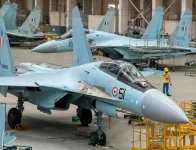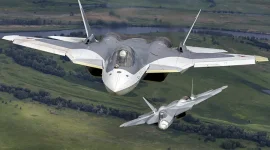- Views: 3K
- Replies: 14

India's western border with Pakistan presents a challenging security environment, requiring robust defence against a variety of aerial threats.
As India's mechanized forces patrol this volatile region, they face a growing vulnerability: an aging air defence network that struggles to effectively counter modern threats like drones, helicopters, low-flying aircraft, and precision-guided munitions.
While legacy systems such as the Soviet-era OSA-AKM (designated SA-8 Gecko by NATO) and handheld Igla missiles have been in service for many years, their limitations are becoming increasingly apparent.
The limitations of these older systems create potential gaps in India's air defenses that could be exploited by adversaries. The western frontier, which spans diverse terrains from the arid plains of Rajasthan to the mountainous regions of Jammu and Kashmir, demands a comprehensive defence.
The Indian Army's short-range air defence (SHORAD) currently relies heavily on the OSA-AKM, a system inducted in the 1980s. The OSA-AKM's 10-kilometer range and older radar technology make it less effective against stealthy or fast-moving modern threats.
Another system, the Tunguska Self-Propelled Anti-Aircraft Gun (SPAAG), also dates back to the Cold War and faces challenges with spare parts availability.
Handheld missile systems like the Igla-1M and Igla-S, while portable, are limited by their 5-6 kilometer range, which is insufficient to counter the growing drone capabilities of Pakistan or the potential threat from Chinese aircraft like the J-10 and H-6 bombers.
The Indian Army's fast-moving mechanized units, including tanks, infantry fighting vehicles, and artillery, require a mobile and layered defence system to protect them effectively.
The current air defence systems, originally designed for a different era, are not well-suited to counter the low-altitude, high-speed threats that are prevalent on modern battlefields.
While India is developing indigenous systems like the Akash-NG and the Quick Reaction Surface-to-Air Missile (QRSAM), these are still undergoing testing and are not expected to be fully inducted before 2026. This creates a critical interim gap in India's defence capabilities.
The Russian-made Pantsir-S1 presents a potential solution to address this gap. Developed by the KBP Instrument Design Bureau, the Pantsir-S1 is a short-to-medium-range system that combines twelve 57E6-E missiles with twin 30mm autocannons.
This hybrid system has a range of 20 kilometers and can reach altitudes of 15 kilometers.
The Pantsir-S1's phased-array radar can track up to 20 targets and engage four simultaneously. It also includes an electro-optical backup system to counter jamming attempts.
The system is operated by a three-person crew and is typically mounted on a wheeled 8×8 chassis (though tracked variants exist), providing a combination of mobility and firepower. The Pantsir has seen use in conflicts like the Syrian Civil War, where it was reported to successfully intercept drones and missiles.
The Pantsir's capabilities are particularly relevant to India's needs. It offers a greater range than the OSA-AKM and Igla systems, can engage drones at 4 kilometers using its autocannons, and can engage aircraft or cruise missiles at 20 kilometers with its missiles.
Critically, its mobility allows it to keep pace with mechanized formations, a vital requirement for operations in areas like the plains of Punjab or the deserts of Rajasthan.
The potential acquisition of the Pantsir system is also attractive from a timing perspective. The Pantsir is an off-the-shelf system, meaning it could be deployed relatively quickly compared to the development timelines of India's indigenous systems.
While the Akash-NG and QRSAM are promising, they are not expected to be fully operational for several years. In the meantime, the threat posed by drones like Pakistan's Harop and the Turkish-supplied Bayraktar TB2, as well as China's loitering munitions, is immediate. An interim purchase of the Pantsir could provide a crucial stopgap, bolstering India's defenses until its own systems are ready.
Further enhancing the potential deal is a November 2024 agreement between Russia and Bharat Dynamics Limited (BDL) to explore co-production of the Pantsir.
Previous trials of the wheeled Pantsir in India reportedly encountered mobility issues in desert terrain. However, a tracked variant, specifically adapted to India's diverse environments, is being considered.
Local assembly under the "Make in India" initiative could potentially reduce costs (estimated to be between $15-20 million per unit) and alleviate the spare parts problems that have affected the Tunguska system.
While the Pantsir is not without its potential challenges. Although integration with India's existing Russian-sourced equipment, such as the S-400 air defence system and MiG-29 fighter jets, is expected to be relatively straightforward, compatibility with Western or indigenous systems like the Akash has not been fully tested.
Potential sanctions under the U.S. Countering America's Adversaries Through Sanctions Act (CAATSA) are also a consideration, although Russia's use of alternative payment methods, such as UAE dirhams for S-400 transactions, may offer a possible solution.
While some critics argue that procuring a foreign system is unnecessary given the nearing readiness of the QRSAM. However, the immediate need for enhanced air defence capabilities along the western border may outweigh the desire to wait for the full deployment of indigenous systems. Acquiring an advanced system like the Pantsir could rapidly bridge the existing operational void.


